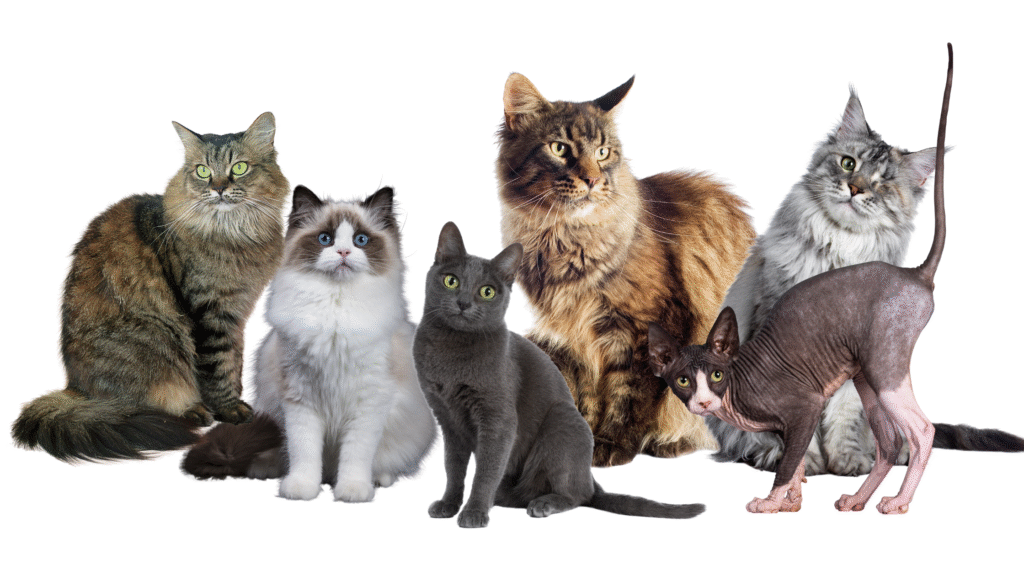Introduction: When Genetics Meet Lifestyle
Every breed tells a story — of centuries of selection, adaptation, and purpose. But with that history comes a genetic predisposition to certain diseases.
As veterinarians, we see daily how lifestyle, diet, and physical activity can either trigger or buffer those genetic tendencies.
Understanding the most common breed-related health issues — and how to manage them proactively through diet and exercise — allows us to shift from treatment to prevention.

Common Diseases in Dogs and How to Manage Them
1. Small Breeds: Tiny Bodies, Big Challenges
Examples: Chihuahua, Cavalier King Charles Spaniel, Pomeranian, Shih Tzu
Common issues:
- Dental disease: overcrowded teeth, tartar buildup, early periodontal disease.
- Luxating patella: common in toy breeds with shallow knee grooves.
- Cardiac disease: especially mitral valve disease in Cavaliers.
Diet & Exercise Principles:
- Prioritize dental-friendly kibble or mixed diets that reduce plaque formation.
- Maintain lean body condition — extra weight increases strain on joints and heart.
- Encourage frequent short walks and gentle play rather than high-impact activities.
- Consider controlled portions to prevent obesity — one of the main aggravating factors for small-breed disorders.
2. Medium Breeds: Active Lifestyles and Allergic Tendencies
Examples: Labrador Retriever, Golden Retriever, Beagle, Cocker Spaniel
Common issues:
- Obesity and hypothyroidism leading to metabolic slowdown.
- Allergies (food and environmental): frequent in retrievers.
- Hip and elbow dysplasia.
Diet & Exercise Principles:
- Choose moderate-calorie diets with high-quality protein and omega-3s to reduce inflammation.
- Maintain regular low-impact exercise like swimming or controlled fetch sessions to protect joints.
- For allergy-prone dogs, support the skin barrier with balanced fatty acids and avoid unnecessary dietary diversity.
- Reassess body condition monthly — a BCS score of 4–5/9 should be the goal.
3. Large and Giant Breeds: Strong, Sensitive, and Slow to Mature
Examples: German Shepherd, Great Dane, Saint Bernard, Mastiff
Common issues:
- Joint disease (hip dysplasia, arthritis)
- Gastric dilatation-volvulus (bloat)
- Cardiac conditions (dilated cardiomyopathy)
Diet & Exercise Principles:
- Feed smaller, frequent meals to minimize GDV risk; avoid exercise right before or after eating.
- Keep protein high and fat moderate, with controlled calcium/phosphorus for growing dogs.
- Prioritize steady, low-impact activities — long walks, swimming, gentle strength work.
- Avoid excessive jumping or running on hard surfaces, especially during growth stages.

Common Diseases in Cats and How to Support Them
1. Persian and Exotic Breeds: Beauty with Delicate Balance
Common issues:
- Polycystic kidney disease (PKD)
- Brachycephalic airway challenges
- Eye and skin sensitivities
Diet & Exercise Principles:
- Encourage hydration through wet food or fountains to support kidney function.
- Offer short, frequent play sessions to prevent weight gain without respiratory strain.
- Keep the environment clean and stress-free — Persians are particularly sensitive to environmental change.
2. Siamese, Burmese, and Oriental Breeds: The Vocal Athletes
Common issues:
- Respiratory sensitivities
- Gastrointestinal upset (IBD tendencies)
- Cardiac hypertrophy in some lines
Diet & Exercise Principles:
- Promote digestive stability through consistent feeding routines and high-quality protein sources.
- Include interactive play to satisfy their high energy without overstimulation.
- Monitor weight — they tend to stay lean but may mask early cardiac changes if activity declines.
3. Maine Coon, Ragdoll, and Large Cat Breeds: Gentle Giants
Common issues:
- Hypertrophic cardiomyopathy (HCM)
- Joint stress due to size
- Obesity in indoor lifestyles
Diet & Exercise Principles:
- Maintain controlled calorie intake; large cats often overeat due to boredom.
- Encourage climbing, chasing, and interactive feeding to activate natural agility.
- Include fish-based or omega-3–rich diets to support cardiac and joint health.
4. Domestic Short/Long Hair Cats: The Everycat’s Challenges
Common issues:
- Obesity and diabetes mellitus
- Urinary tract disease
- Dental issues
Diet & Exercise Principles:
- Transition to wet or mixed feeding to increase water intake and prevent urinary issues.
- Create vertical spaces and enrichment activities — climbing, chasing, and pouncing mimic natural movement.
- Schedule two to three short play sessions daily to combat inactivity.
Lifestyle as Medicine
Breed predispositions are not destinies. With proper diet and movement, we can significantly delay — or even prevent — the onset of many chronic diseases.
Encourage clients to see nutrition and exercise as therapeutic tools, not just daily habits.
Here’s what makes the biggest difference:
- Routine weight checks and body condition scoring.
- Structured feeding instead of free access to food.
- Daily activity, adapted to age, size, and medical history.
- Preventive screenings for breed-related diseases starting at mid-life.
Final Thoughts: From Genetics to Wellness
Every dog and cat has a genetic blueprint — but lifestyle writes the final chapter.
Through balanced nutrition, moderate exercise, and proactive monitoring, veterinarians can help pet owners move from managing disease to nurturing lifelong vitality.
The goal isn’t perfection — it’s prevention, compassion, and partnership in care.
Talk to your veterinarian about your pet’s breed predispositions — and get a personalized nutrition and exercise plan that keeps them healthy from nose to tail.







